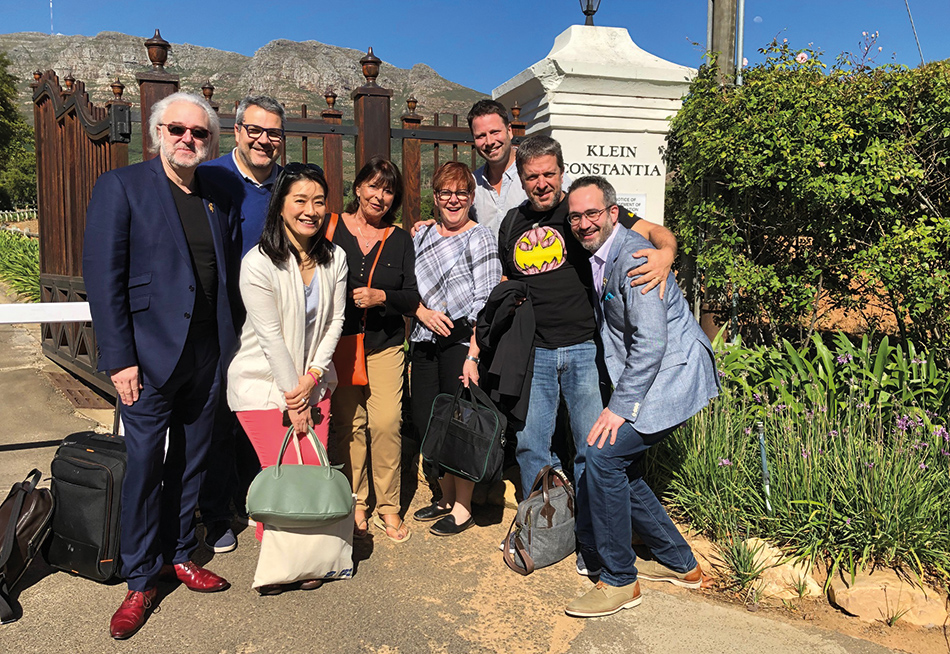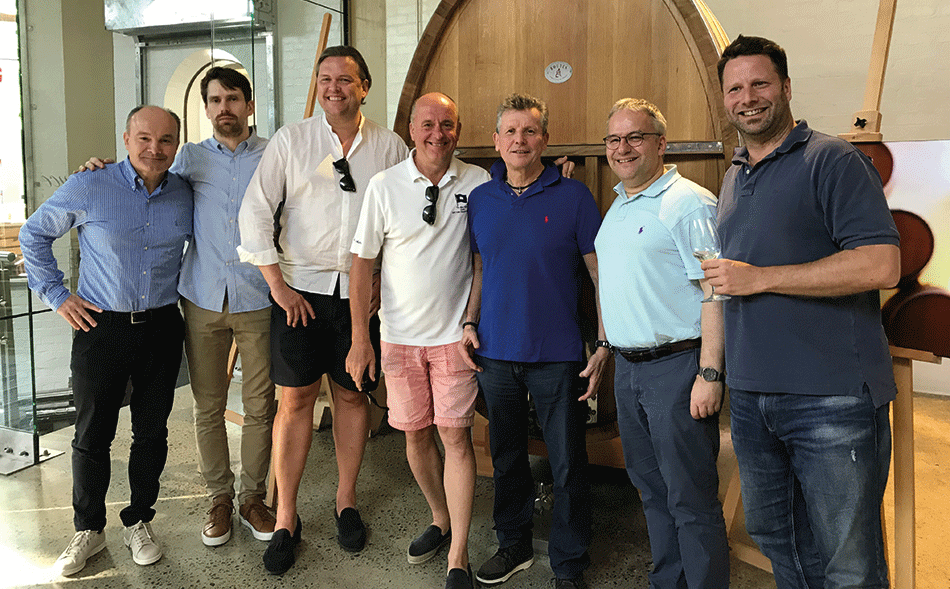
Last January, the members of the Board of Association de la Sommellerie Internationale, then of the Technical Committee of the Contest of the Best Sommelier of the World 2019, gathered in South Africa, in the region of Cape Town, at the Klein Constantia wine estate, one of the most mythical vineyards in the world. At the invitation of Hans Aström, General Manager and largely responsible for the new face of Klein Constantia and its wines.
When you arrive near Klein Constantia, you are struck by the beauty of the vineyards on gentle slopes in the foothills of the Table Mountain. It’s orderly nature, lined-up rows of vines, very graphic, with these pretty Dutch-style white houses of the 17th century. A real painting. Then you realize that this situation between the Atlantic Ocean and the Indian Ocean is quite exceptional. Unique. Six kilometers on each side as the crow flies. Then you understand the role of the Cape Doctor, this wind from the Cape that avoids so many diseases in the vineyard.
And yet, despite this privileged geographical location, Klein Constantia did not escape oïdium then phylloxera. This largely explains the disappearance of the famous Vin de Constance for almost a century...
The history of this wine is really exceptional. It dates back to 1685, long before Yquem, when Simon van der Stel, the first governor of the Cape, seduced by the region, decided to create a vineyard he named after his daughter Constantia. Among others, he imported Muscat de Frontignan and Chenin Blanc grape varieties. And the sweet wine of Constantia, the liquid gold, was very quickly prized by the Courts of Europe, from Frederick the Great to Queen Victoria, as well as Versailles. And even in the United States, where President Thomas Jefferson was a great wine lover and collector. In France, it is now called the Wine of the Emperor because Napoleon used to regularly drink it during his exile in St. Helene. But poets and novelists were equally sensitive to it. Baudelaire, Dickens, Jane Austen...
In the middle of the 19th century, Klein Constantia experienced a very difficult period and the Vin de Constance even completely disappeared in 1898 to be reborn only in 1986. Thanks to the obstinacy and research work of Duggie Jooste, its new owner, professor ampelographer Orffer and winemaker Ernst Le Roux who managed to identify not only the original grape varieties but also the traditional winemaking process of Vin de Constance. The Muscat de Frontignan from the very beginning could even be cloned. All conditions were then met to revive the famous Vin de Constance.
Today, it is subjected to the greatest care, from the vine to the bottling. Successive picking of the berries dried on the stocks, destemming, maceration, fermentation, ageing in thermo-regulated stainless steel vats and oak barrels (97% French, 2% Hungarian and 1% acacia) for a period of three to five years. Then various successive blends are made, tasted in several sessions by a panel of experts. For the 2016 vintage, several Best Sommeliers of the World—Serge Dubs, Markus Del Monego, Olivier Poussier, Andreas Larsson and Arvid Rosengren—have thus contributed to the subtle balance of Vin de Constance for which Hans Aström emphasizes that “it is a dry wine with some sweetness” ... A nice acidity gives it the freshness that counterbalances the sweetness and gives such a sensation of lightness, elegance.

But Klein Constantia is not just about Vin de Constance. The estate also produces excellent dry wines made from Sauvignon Blanc, Chardonnay, Cabernet Sauvignon, Syrah ... as well as a great Cap Classique, thanks to a young Cellar Master, Matt Day, appointed by Hans Aström from the beginning in 2012 and who works wonders. The collaboration with Pascal Jolivet for Metis, a wine made from Sauvignon Blanc, has also marked the winemaking policy of the estate with a holistic approach.
Klein Constantia’s new era started in 2012, just after the acquisition of the estate in May 2011 by Czech-American investor and philanthropist Zdenëck Bakala and British businessman Charles Harman. The merger of Klein Constantia and the Anwilka vineyard (Stellenbosch) in June 2012 brought two new shareholders, Bruno Prats (former owner of Château Cos d’Estournel in Saint-Estèphe) and Hubert de Boüard (co-owner of Château Angélus in Saint-Emilion) and created a synergy that is very beneficial to both wineries.
Upon his arrival, Hans Aström, after more than 25 years in the wine world, sommellerie then international business (Peter Lehmann, Hess Family), set up a program to give back to Klein Constantia, and especially to Vin de Constance, their nobility. Native of Sweden, but citizen of the world as he likes to say, Hans, with the support of his shareholders, completely reformed the estate. The choice of men, a cohesive team of specialists, and also the will and the decision to create optimal conditions in the vineyard and the cellar. No more irrigation with city water, recovery of the rainwater, wastewater treatment, solar panels, planting of drought-resistant vines, adoption of advanced techniques for the maintaining and pruning of the vineyard, fight against soil erosion, working with Percherons ... This earned Klein Constantia to be the first estate to be certified organic in 2013. Not to mention a fire brigade and guards to monitor and contain raids of mountain baboons very fond of white grapes, the complete overhaul of the facilities, the redevelopment of the cellars and the tasting room ... And also the restoration of van der Stel’s house and the historic cellar, the creation of a Bistro and a shop, everything is done to magnify Klein Contantia. It’s the constant search for excellence at all levels!
“We are privileged to be the guardians of one of Cape Town’s most historic properties and we consider the preservation of this heritage as a great responsibility.”
The whole team of Association de la Sommellerie Internationale could work in optimal conditions and also discover the great South African white Chenins, old vintages of various appellations of South Africa at Twelve Apostles, the project of the old vines and the Cabernet Collective at Green Goose in Stellenbosch, a discovery encounter with the winemakers of the Hemel-en-Arde Valley (Hermanus) at Ataraxia’s wine lounge, followed by the lunch-tasting tour at Hamilton-Russell. A superb experience thanks to Klein Constantia and SASA, the Association of Sommeliers of South Africa, who have concocted this wonderful program.
And many thanks again to Zdenëk Bakala, Hans Aström, Matt Day and all Klein Constantia staff, Higgo Jacobs, Barry Schoffield and JV Ridon, SASA, Olive and Anthony Hamilton Russell, Ina Smith, Chenin Blanc Association, Justin Van Wyk of Constantia Glen, David Clarke, ex-animo, Roland Peens, wine cellar, Chris Williams, Meerlust, Lucas van Loggerenberg, Andre Morgenthal, Old Vine Project, Christo Le Riche, Cabernet Collective, Gustaaf Boshoff, the Green Goose Craig Wessels, Hemel & Aarde growers association, Kevin Grant, Ataraxia and all those who have also contributed to the success of this beautiful project and have thus facilitated the preparation of the Contest of the Best Sommelier of the World in a wonderful atmosphere ...
Michèle Aström Chantôme